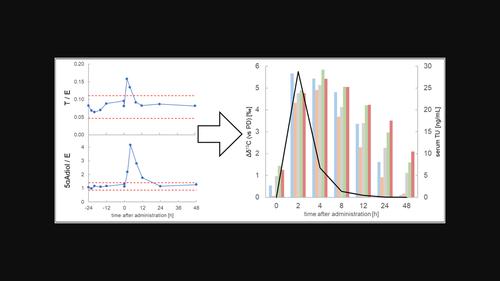当前位置:
X-MOL 学术
›
Drug Test. Anal.
›
论文详情
Our official English website, www.x-mol.net, welcomes your feedback! (Note: you will need to create a separate account there.)
Comparison of analytical approaches for the detection of oral testosterone undecanoate administration in men
Drug Testing and Analysis ( IF 2.9 ) Pub Date : 2024-01-11 , DOI: 10.1002/dta.3638 Tobias Langer 1, 2 , Raul Nicoli 1 , Carine Schweizer‐Grundisch 1 , Silke Grabherr 2 , Tiia Kuuranne 1 , Alessandro Musenga 1
Drug Testing and Analysis ( IF 2.9 ) Pub Date : 2024-01-11 , DOI: 10.1002/dta.3638 Tobias Langer 1, 2 , Raul Nicoli 1 , Carine Schweizer‐Grundisch 1 , Silke Grabherr 2 , Tiia Kuuranne 1 , Alessandro Musenga 1
Affiliation

|
For antidoping laboratories, the determination of an illicit testosterone (T) administration in urine samples remains a difficult process as it requires the determination of the exogenous origin by carbon isotope ratios (CIRs) of testosterone and its metabolites. As a complement to the urinary analysis, targeting testosterone esters (e.g. testosterone undecanoate [TU]) in serum samples by liquid chromatography coupled to tandem mass spectrometry (LC–MS/MS) could represent a simpler approach compared with isotope ratio mass spectrometry (IRMS). These two approaches both lead to the direct detection of the administration of exogenous T but with a difference in effort and complexity of the analysis. To compare the detection window obtained with the two strategies, serum and the corresponding urine samples collected from an administration study with oral TU were analysed. Results showed that, at all timepoints where the intact TU was detected in serum, the CIRs of urinary steroids were also not in agreement with an endogenous origin. IRMS analysis required more effort but resulted in slightly longer detection windows than the ester analysis. Finally, this comparison study showed that, in the presence of a suspicious urinary steroid profile, the LC–MS/MS steroid esters analysis in the corresponding serum samples can be very helpful. If steroid esters are not detected, the IRMS analysis can then be conducted on the urine sample afterwards. Overall, the combination of matrices might facilitate the detection of prohibited T administration in sports, especially for athletes with naturally low T/E ratios.
中文翻译:

男性口服十一酸睾酮检测分析方法的比较
对于反兴奋剂实验室来说,确定尿液样本中的非法睾酮(T)施用仍然是一个困难的过程,因为它需要通过睾酮及其代谢物的碳同位素比(CIR)来确定外源来源。作为尿液分析的补充,通过液相色谱与串联质谱联用 (LC-MS/MS) 检测血清样品中的睾酮酯(例如十一烷酸睾酮 [TU])可能是比同位素比质谱 (IRMS) 更简单的方法)。这两种方法均可直接检测外源 T 的施用,但分析的工作量和复杂性有所不同。为了比较两种策略获得的检测窗口,对口服 TU 给药研究中收集的血清和相应尿液样本进行了分析。结果表明,在血清中检测到完整 TU 的所有时间点,尿类固醇的 CIR 也与内源性来源不一致。IRMS 分析需要更多的努力,但检测窗口比酯分析稍长。最后,这项比较研究表明,在存在可疑的尿类固醇谱的情况下,对相应血清样品中的 LC-MS/MS 类固醇酯进行分析非常有帮助。如果未检测到类固醇酯,则随后可以对尿样进行 IRMS 分析。总体而言,矩阵的组合可能有助于检测运动中禁止的 T 给药,特别是对于天然 T/E 比率较低的运动员。
更新日期:2024-01-12
中文翻译:

男性口服十一酸睾酮检测分析方法的比较
对于反兴奋剂实验室来说,确定尿液样本中的非法睾酮(T)施用仍然是一个困难的过程,因为它需要通过睾酮及其代谢物的碳同位素比(CIR)来确定外源来源。作为尿液分析的补充,通过液相色谱与串联质谱联用 (LC-MS/MS) 检测血清样品中的睾酮酯(例如十一烷酸睾酮 [TU])可能是比同位素比质谱 (IRMS) 更简单的方法)。这两种方法均可直接检测外源 T 的施用,但分析的工作量和复杂性有所不同。为了比较两种策略获得的检测窗口,对口服 TU 给药研究中收集的血清和相应尿液样本进行了分析。结果表明,在血清中检测到完整 TU 的所有时间点,尿类固醇的 CIR 也与内源性来源不一致。IRMS 分析需要更多的努力,但检测窗口比酯分析稍长。最后,这项比较研究表明,在存在可疑的尿类固醇谱的情况下,对相应血清样品中的 LC-MS/MS 类固醇酯进行分析非常有帮助。如果未检测到类固醇酯,则随后可以对尿样进行 IRMS 分析。总体而言,矩阵的组合可能有助于检测运动中禁止的 T 给药,特别是对于天然 T/E 比率较低的运动员。



























 京公网安备 11010802027423号
京公网安备 11010802027423号